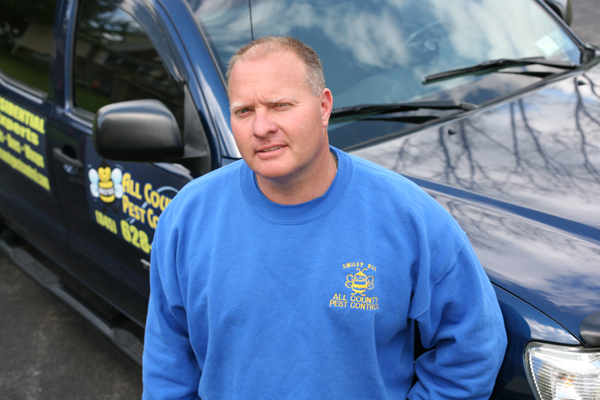
A few headlines come to mind after a conversation with Ed Binns:
Invasion of the Keystone stinkbugs!
My day in a rat-filled crawlspace!
The headlines are true, but they serve to obscure the larger picture, one that dates to 1963 and involves Mahopac-based All County Pest Control and three generations of the Binns family: founder and father William; Ed, who took over in 1993; and now Ed”™s two children: 19-year-old Colleen, and 16-year-old summertime worker Brian.
Binns works only in New York. Having mastered and kept abreast of New York”™s regulations, he said, “We expanded north-south into Westchester ”“ we”™ll go as far south as Scarsdale ”“ and into southern Dutchess instead of east-west into other states.” He bristles politely at New York”™s regulatory burden while stating forthrightly: “We see and understand the need for regulations.”
Binns”™ state Department of Environmental Conservation certificates are for structural and rodent; termite; food processing; public health; aquatic insect; aquatic plant; ornamental turf and a separate DEC-issued nuisance wildlife trapping license.
“New York is considered the worst state for regulations,” he said. “Particularly in our region, we have a lot of groundwater regulations. A lot of our water supplies the population of New York City.
“The standardized solution was to take Long Island soil data and wildlife data and apply it to the state,” Binns said. The problem with that, he said, is Long Island”™s soil is sandy, which does not suspend chemicals, but rather shunts them quickly to aquifers, the source of 100 percent of Long Island”™s water.
Termites and Temik help explain the difference between Mahopac and Montauk. On Long Island, Binns said, termites are a big problem. “They can plow right through the sandy soil,” he said. “We don”™t have a big termite problem here. They have a tough time getting through the soil.” Binns also knew of Temik, the Rhone-Poulenc brand pesticide the EPA set about banning in 2010 ”“ with the ban to be complete by 2017 ”“ but which was banned on Long Island in 1980 for the same reasons termites love it: sandy soil.
“The National Pest Management Association has been active on this issue, but New York is still the most regulated state,” said Binns.
All County handles most pests and scales, working for businesses and private homes. “The only thing we don”™t do are schools,” he said. “They have a nonchemical policy.”
Most pests are in All County”™s crosshairs. For bats, however, Binns calls a specialist; same with honeybees, which are collected by beekeepers. Raccoons and squirrels are trapped. He would prefer not to do snakes. Carpenter ants ”“ the big black ones ”“ wasps and yellow jackets constitute his three biggest pests. As he spoke recently, Binns said he was investigating regulations for cicadas ”“ due for their 17-year din beginning now ”“ and stinkbugs.
Stinkbugs reportedly landed in Allentown, Pa., in 1998 from the Orient and have been fanning out ever since. “The epicenter is Pennsylvania, but they”™re moving out in all directions,” Binns said. “We get them, though not at Pennsylvania levels.” A stinkbug seminar could be on the horizon: “They”™re crafty,” he said. “And they have pesticide resistance already.”
All County now boasts six employees, a spanking new office next to the old one at 5 Veschi Lane South and four company vehicles.
As for the job he dreads most, it is surprisingly not the squeaking Norway rats Binns has encountered ”“ even en masse in a tight crawlspace ”“ or the hissing Virginia possums. “Bed bugs,” he said. “Fortunately, they”™re not huge in our market. We are a residential, middle- and high-class area. No hotels. We”™re really mild with bed bugs and that”™s fine. I don”™t enjoy them.”















Comments 1